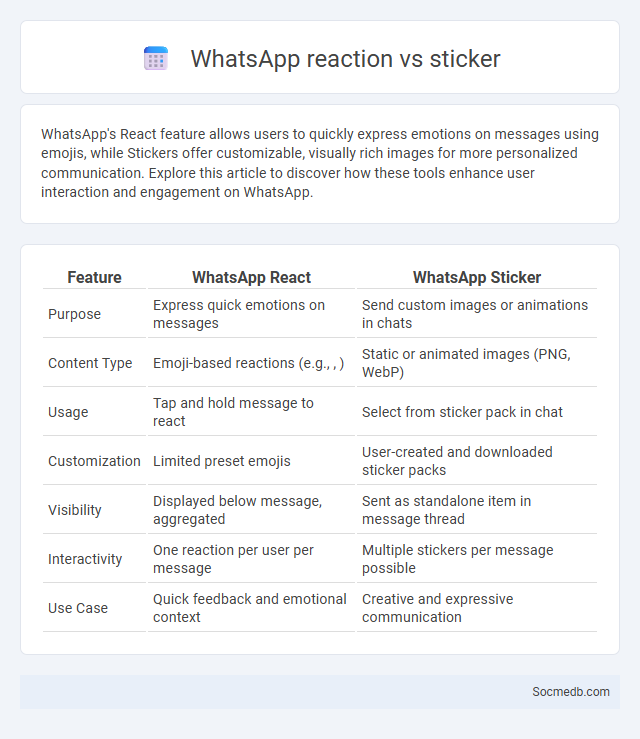
Photo illustration: WhatsApp react vs sticker
WhatsApp's React feature allows users to quickly express emotions on messages using emojis, while Stickers offer customizable, visually rich images for more personalized communication. Explore this article to discover how these tools enhance user interaction and engagement on WhatsApp.
Table of Comparison
| Feature | WhatsApp React | WhatsApp Sticker |
|---|---|---|
| Purpose | Express quick emotions on messages | Send custom images or animations in chats |
| Content Type | Emoji-based reactions (e.g., , ) | Static or animated images (PNG, WebP) |
| Usage | Tap and hold message to react | Select from sticker pack in chat |
| Customization | Limited preset emojis | User-created and downloaded sticker packs |
| Visibility | Displayed below message, aggregated | Sent as standalone item in message thread |
| Interactivity | One reaction per user per message | Multiple stickers per message possible |
| Use Case | Quick feedback and emotional context | Creative and expressive communication |
Introduction to WhatsApp Message Interactions
WhatsApp message interactions encompass text exchanges, multimedia sharing, voice notes, and real-time communication within private chats or group conversations. This platform supports end-to-end encryption, ensuring secure message delivery and privacy between users. Understanding WhatsApp interactions involves analyzing message patterns, response times, and engagement levels across diverse social connections.
Understanding WhatsApp Reactions
WhatsApp Reactions allow users to quickly express feelings on messages using emojis, enhancing communication efficiency and emotional clarity. This feature supports seven distinct emojis, including thumbs up, heart, laughter, surprise, sadness, and thanks, fostering more interactive and engaging conversations. By integrating reactions, WhatsApp reduces message overload while preserving conversational context in both individual and group chats.
Exploring WhatsApp Stickers
WhatsApp stickers offer a dynamic way to enhance communication by expressing emotions and ideas visually, making conversations more engaging and personalized. Users can create custom stickers from photos or download sticker packs, facilitating creative self-expression and cultural sharing within messaging threads. The growing popularity of WhatsApp stickers reflects their influence on digital communication trends and user interaction patterns globally.
The Concept of Reacting to Messages
Reacting to messages on social media allows you to quickly express emotions and responses without typing a full reply, enhancing communication efficiency. Popular platforms like Facebook, Instagram, and Slack offer diverse reaction options such as likes, hearts, and emojis to convey sentiment instantly. Utilizing these features can boost engagement and foster more dynamic interactions within your online community.
Differences Between Reactions and Stickers
Reactions on social media are quick, one-click responses such as likes, loves, or emojis that convey immediate emotions without text, whereas stickers are often larger, more detailed images or animations used to express feelings or messages creatively. You can use reactions to engage swiftly with posts, providing a simple emotional feedback, while stickers offer a personalized and visually appealing way to enhance conversations. Both tools serve different purposes in boosting interaction and enriching your social media experience.
Usability: When to Use Reaction vs Sticker
Use reactions on social media to quickly express emotions or feedback with minimal effort, ideal for real-time conversations or posts requiring brief acknowledgment. Stickers offer a more personalized and visually engaging way to communicate, suitable for enhancing messages with humor, creativity, or specific themes. Choosing between reactions and stickers depends on the context: reactions support swift interactions, while stickers foster deeper emotional connection and expression.
Expressing Emotions: React vs Sticker Comparison
React buttons on social media provide quick, intuitive ways for you to express emotions such as like, love, laughter, or surprise with minimal effort, enhancing engagement on posts and comments. Stickers offer a more personalized and visually creative method to convey emotions, often incorporating animations or custom designs that add personality and context to your responses. Choosing between Reacts and Stickers depends on whether you prefer speed and simplicity or detailed emotional expression in your online interactions.
Group Chats: Effectiveness of Reactions and Stickers
Group chats enhance communication efficiency by enabling quick responses through reactions and stickers, reducing message clutter while conveying emotions clearly. These interactive elements foster engagement and improve group dynamics by allowing members to express agreement, humor, or support instantly. Your use of stickers and reactions can significantly boost clarity and connection within social media group conversations.
Privacy and Notification Impacts
Social media platforms significantly influence user privacy by collecting extensive personal data that can be exploited for targeted advertising and unauthorized surveillance. Notification systems on these platforms are designed to increase user engagement, often causing frequent interruptions that impact mental well-being and productivity. Managing privacy settings and customizing notification preferences are critical steps for users to protect their information and maintain control over their social media experience.
Future Trends in WhatsApp Message Interactions
WhatsApp is poised to integrate advanced AI-driven chatbots enhancing personalized message interactions and customer support experiences. Enhanced encryption technologies will ensure higher privacy standards while introducing features like disappearing messages and context-aware replies to improve user engagement. Real-time multimedia sharing and integrated payment systems will transform WhatsApp into a comprehensive communication and transaction platform by 2025.
 socmedb.com
socmedb.com